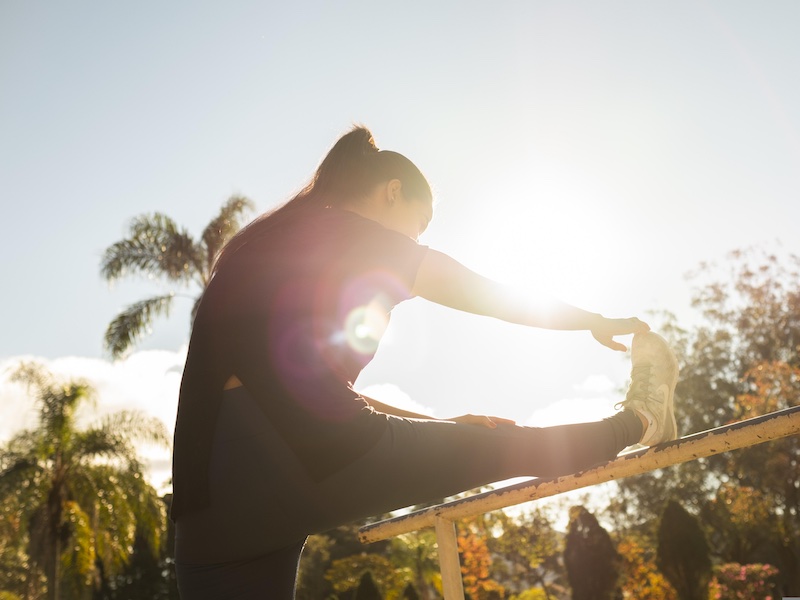Whether it’s the demands of work, the responsibilities of family, or simply struggling to muster up the energy, incorporating movement into our routines often takes a back seat.
Keeping our bodies active is key for mobility and joints, cardiovascular and respiratory health, mental wellbeing and so much more. Our schedules can become overwhelmingly busy and the idea of finding time and motivation to go to the gym or for a run each day begins to sound impossible. Fellowes released findings that 81% of UK office workers are sitting at their desks every day for between 4 and 9 hours. That adds up to about 67 days per year spent completely sedentary and that’s just for work. This means it is essential to find practical and effective ways to integrate different types of movement into your routine in a way that works with your lifestyle instead of against it.
Tie it into your existing routine:
Habit building is the key to sustainable change and one of the best ways to build new habits is by connecting them to ones that are already well established in your routine. Start by asking yourself what are things you automatically do every single day and assign a partner activity. It doesn’t need to be some heavy workout that disrupts what you’re doing, aim for something that can seamlessly use the time during that task. Small but consistent long-term efforts can make a significant impact. For instance, while brushing your teeth, try doing calf raises. Waiting for the kettle to boil for your morning cup of tea? Maybe some gentle squats or side stretches. You can even stay active while at your desk.
If the first thing you do when you sit down at your desk is to check your emails, then you can roll and flex your wrists and ankles while you do so. It’s especially important to engage in regular stretching if the majority of your day is spent in the same positions in order to avoid straining and compromised mobility. While you’re solidifying your new habits, leaving sticky notes can be a great reminder. These micro-moments of movement not only add up over time but also become second nature, transforming your daily rituals into opportunities for physical engagement.
Avoid it being a chore:
When you’re tired and busy, you’re much less likely to be motivated to do something you have to force yourself to get through. Turning monotonous activity into something that brings you joy is the easiest way to ensure you keep showing up. Take time to reflect on what is your type of fun, not what anyone else says you should be spending your time doing. There’s an activity for all mindsets and needs.
If you’re a social person, then let it be a reason to hang out with your friends. Try a class together, join some team sports or give each other some emotional support as you navigate the gym together.
If you want to be spending as much time with family as possible, then find a Zumba video on YouTube so the kids or partner can get involved with some high-energy fun in the living room. Maybe what you’d enjoy most is some peaceful solo time to recharge, find yourself a quiet space and take your body through some solitary yoga. If nature helps to recharge you then instead of going for the same walk every day, find beautiful outdoor spots that you would be excited to explore, and make it an adventure. Or if the way to your heart is through your inner child, then allow yourself to play.
Just because you’re an adult, doesn’t mean you have to do boring activities. Go to a trampoline park, swing through the trees at a high ropes course or revisit a hobby you had when you were younger. Movement should be a gift to your body and mind, not a punishment.
Find your style:
One size does not fit all when it comes to exercise. There may be a new trending exercise on social media or a fitness plan that changed your friend’s life, but that doesn’t mean it’ll be right for you. Personally, I absolutely love yoga and weightlifting, but I would be miserable if I had to go for a run. The best way for you to stay fit is the one that you keep showing up for, and remember, it’s okay for that to change over time.
Let yourself try things and get inspired. If you can’t motivate yourself to get on the treadmill, it doesn’t mean you’re lazy or bad at exercise, it just means that that’s not a good fit for you. There’s still cycling, swimming, dancing, boxing, rowing, aerobics and that’s only scratching the surface. Sure, there will always be days where even if you love the activity you still have to drag yourself out of bed to do it. But if you’re fully immersed in the activity and nothing about it brings you joy, maybe it’s time to try something different. Finally, you don’t have to be perfect at what you’re passionate about. You can have 2 left feet and still deserve a place in a dance class, you can go to the gym to use the smallest weights and still be proud of the victory that is taking action for your health.
Break down your goals:
Long-term goals and challenges can be a great motivator, but if it’s all you focus on then it can also become extremely overwhelming. There’s nothing wrong with aiming to run a marathon before you’ve even gone for your first run, dreaming big can help pull you through the plateaus and difficult milestones. But if you expect yourself to be really close to your long-term goals on day 1, it’s easy to become intimidated and even discouraged when it feels like you’ve got a long way to go. It can lead to negative self-talk, losing perspective and giving up.
The way to avoid this is by taking your huge goals and breaking them down into small consistently achievable milestones. The dopamine hit of achieving these steps helps to fuel your journey. If my client has a goal of bench pressing 100kg, the plan isn’t 100kg is success and everything before that is failure. It’s about celebrating every single victory that gets them closer to the final boss. Last week they were lifting 20kg and now they’re lifting 30kg? That’s a huge win because it’s progress, it doesn’t matter if 100kg is still a long way off. Keeping your eyes on the prize is great, but make sure you’re reflecting on your achievements along the way, it’ll do wonders for your confidence and motivation.
Incorporating movement into your daily routine doesn’t have to be a Herculean task. Take it one step at a time and be honest with yourself about what works for you. Be kind to yourself, try out as much as you can and remember that sustainable healthy choices aren’t ones that make you miserable.
About the author

Jess Forster is a Holistic Health & Wellness Specialist and Founder of Empowered Health Education. As a licensed yoga teacher with qualifications ranging across nutrition, physical training, mental health and hormone management, Jess works with her clients to map out and execute a balanced health plan that addresses the full picture. She is dedicated to empowering individuals to take control of their own well-being through education, support and personalised guidance. She specialises in providing a practical, realistic and compassionate approach to health, with an emphasis on understanding and supporting the different needs of an individual, instead of a one-size-fits-all mindset.
Connect with Jessica Empowered Health Education | Linkedin |. Instagram








